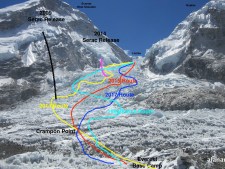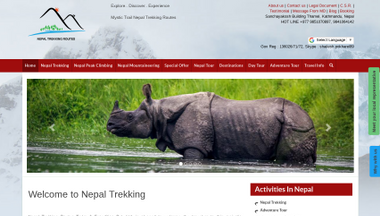Himalayan climbers risk everything: time, money, career, comfort, health, even their lives. In the case of women, the toll seemingly also includes motherhood.
According to records, avid female mountaineers tend to delay childbirth and give up the passion altogether once they become mothers. The men instead, keep climbing.
It seems to come down to a difference in circumstances. Alison’s husband was somewhat willing to care for their kids while she was away but her situation has proved unique. There are virtually no mothers climbing in Himalaya, and ExWeb’s Angela Benavides caught up with some of today’s women mountaineers to check what they think about it.
Kinga: no chance for a “normal” family life
“It is very difficult for women to climb in the Himalayas and have a ‘normal’ family life at the same time,”  Polish 6x8000ers summiteer Kinga Baranowska, 33, told ExplorersWeb, “most of all when the kids are small.”
Polish 6x8000ers summiteer Kinga Baranowska, 33, told ExplorersWeb, “most of all when the kids are small.”
“Very few women in Poland had kids while they were active climbers – usually they quit climbing the moment they decided to raise a family. Take Anna Okopinska for instance: she was the first female GII summiteer in 1975, and a very good climber.”
Badia: “I guess the men have a wife to take care of their children”
Mexican Badia Bonilla – married to fellow climber Mauricio Lopez – strongly believes in giving up kids while climbing as an act of responsibility.
“In my opinion, we women climbers shouldn’t have children since the risk of having an accident is too high,” Badia told ExWeb. “Such event would affect the kids most than anyone – they would be left orphans or in care by strangers. In my case, at 43 years I can only consider adoption as an option – and would definitely not make such a decision until I’m done with dangerous mountains. Mauricio, my husband, agrees on this.”
“As for male climbers with children at home, they tend to be less strict – their parental feelings are not that strong and therefore they take greater risks,” Bonilla said. “I guess they have a wife to take care of the children should anything happen. However, I have known men giving up close summits alleging they love their kids too much.”
Oh Eun-Sun: “It’s difficult to find a man who understands”
Also 43 years old, South Korean female top climber (13 8000ers) Oh Eun Sun pretty much agrees.
“Himalayan mountains are merciless,” she said. “Therefore, since I started my project I have been fully focused on climbing and never considered to start a family.”
“When climbing in the Himalayas, there is a very thin line separating life and death – critical moments are too common. In addition, expeditions involve long stays abroad, making it extremely difficult to take care of a family at home.”
Moreover, Miss Oh keeps little hope to find a supportive partner while climbing full time. “It’s difficult to find a man sensitive enough to understand the life I lead,” she reflected. “I wish I was lucky to find someone like that: I would definitely marry him right away :-)”
“As for children – I believe I would be unable to focus on the climb while missing them too much,” Eun Sun added. “My parents suffer while I am away – there is nothing I can do about it. But I can at least be serious enough not to get a husband and children involved in my complicated life-style.”
“I would like to have a family after I complete the 14x8000ers project though – as long as I find the right person, that is,” she ended.
Edurne: “It is simply not fair”
Miss Oh’s closest rival in the 14x8000ers race Edurne Pasaban agrees that the right partner is what’s most important. 
“It’s not impossible to have a family and a climbing career at the same time,” the 36 years old Basque climber put down. “As long as you find a ‘special someone’ – that meaning, someone special enough to understand you and support you.”
“Society is rather unfair to female climbers and mothers. Apparently there is nothing wrong with male climbers risking their lives in the mountains while leaving a family at home – but the public often jumps mothers who want to climb. In my opinion, both parents are equally important for a child, and so I see no difference whether it’s the father or the mother who climbs!”
“Right now I am not planning on having children – but that’s just because I’m not in the right circumstances,” Edurne told ExWeb. “I’m constantly on the move, I don’t have a partner, and so I wouldn’t be considering kids even if I did something else for a living.”
“As for the future – of course I don’t discard it; I’d actually like to have children someday, why not?”
“Supermom” Monika Kalozdi: the exception
Younger or older, married or single – avid women mountaineers are apparently bound to choose between climbing and motherhood; they may experience both but not at the same time. Even recreational female climbers with small children are extremely rare, but not non-existent.
“Supermom” Monika Kalozdi of New Orleans somehow managed to run a company, take care of her family, train hard – and climb Cho Oyu and Everest. She checked her kids’ homework over satellite phone and finally dedicated her Everest summit to her three children.
Husband Jeno was key of course. “We have been married 23 years,” Monika said. “From the very beginning Jeno has been my best friend, my business partner, and now my biggest supporter and fan. He is the spirit on my expeditions. He works out all the logistics, finds me all the books and videos I need to study for a climb, and supports and encourages my training schedules. Without him I could not do this.”
“I believe that mom and dad are equally important in raising the family,” Monika added. “Just like we share work, we share the kids. Examples need to be set by both parents, both in parenting as well as in your daily life.”
“As a woman, I believe I have been able to show my daughter that she can do anything she sets her mind to,” Monika said. “And to my boys I believe I have taught them to see women as equals.”
ExWeb co-founder Tina, “we are still in the Dark Ages”
ExWeb’s co-founder Tina Sjogren is an all-round explorer, with a summit of Everest, ski-expeditions to both poles and ocean crossings. Next, she hopes to travel to Mars with her husband Tom. “To me it was an early choice,” she said. “I knew since childhood I wanted a different life.”
“But it’s not easy for any woman to go against society in such a deep-rooted matter as motherhood; I’ve fought both pitty and judgement. We are still primitive animals, and it is part of our nature to reject, attack even, anything that differs from ‘the pack’.”
“We’re selfish they say – which is funny in light of our population problem. We’ll regret it, they threaten, but few speak about those who caved in spending the rest of their lives wondering what might have been. ”
“The guilt trips are stunning, especially those imposed on us by most religions. It’s about power by numbers but believe me, my God has nothing to do with that, that’s a human thing. Our species is not as important in the Universe as we like to think and our purpose goes beyond feeding and breeding (ask any dinosaur). Beside our gene pool, we should consider our legacy.”
“It’s clear from the above interviews that we remain in the Dark Ages when it comes to this issue. Women explorers are damned if they do and damned if they don’t. The message to us is frankly: stay home!”
“As for explorers (of both sexes) putting their kids at risk of becoming orphants: in my experience the memory of an extraordinary parent can be far more empowering than being raised by a bitter or indifferent individual. You can be there (or not) in so many ways.”
“There are so many musts and shouldn’ts, we attack mothers who are too young, too old, have too many kids, or none at all. We are much less worried about justice, freedom and progress. Women can only shine if they live by a strong, free will. And so while I’m different, to those who want many kids I say go for it, heck, have 2 more on me!”
“Whether we choose to have children at age 15, 65 or not at all; I hope that our independent decisions will empower both sexes to live by their hearts rather than society’s norms. Such lives are no doubt the most rewarding and in my mind, the most useful in the big picture of it all.”
* Related Links :
ExWeb interview with Monika Kalozdi
Edurne Pasaban’s website
Badia Bonilla’s website
Oh Eun Sun/Black Yak’s website
Kinga Baranowska’s website
ExWeb’s women series, part 1: Himalaya – no place for mothers?
ExWeb’s women series, part 2: Himalaya – perfect place for a date?
* Polish Himalayas – Become a Fan
Exweb Week-In-Review is sponsored by HumanEdgeTech the world’s premier supplier of expedition technology. Our team helps you find ultra light expedition tech that works globally.
e-mail or call +1 212 966 1928
* Read these stories – and more! – at ExplorersWeb.com






zapraszam do subskrypcji mego bloga
Filed under: Climbers, Expedition, Himalayas, Travel | Tagged: Badia Bonilla, Base Camp, Climbers, Edurne Pasaban, Everest, Expedition, female Himalaya climbers, Himalaya, Kinga Baranowska, Nepal, Oh Eun-sun, Tibet, Travel | 1 Comment »











































